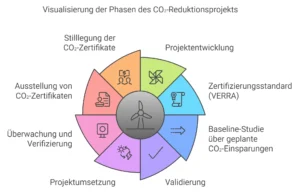The carbon footprint is a measure of the amount of carbon dioxide emissions directly or indirectly caused by our activities. It includes all aspects of our lives, from the energy we consume at home, to how we get around, and the products we consume. By understanding our carbon footprint, we can recognize how our lifestyle contributes to global warming.
It is important to offset this footprint because global warming has severe effects on the climate, including extreme weather events, rising sea levels, and loss of biodiversity. If we don’t act, we not only jeopardize our own future but also that of future generations. Offsetting our carbon footprint means taking actions to reduce or compensate for the amount of carbon dioxide we release into the atmosphere.
This can be achieved through various strategies such as reforestation, using renewable energy, or supporting carbon sequestration projects. By actively addressing and offsetting our carbon footprint, we help mitigate the negative impacts of climate change and create a more sustainable future for everyone. It is a responsibility we should take seriously because each of us has the opportunity to make a positive impact on our planet.
Key Takeaways
- A carbon footprint measures the amount of greenhouse gas emissions caused by your activities, and it is important to offset it to combat climate change.
- You can reduce your carbon footprint in everyday life by switching to public transportation, carpooling, and using energy-efficient appliances.
- To reduce your energy consumption at home, you can switch to LED lights, turn off appliances when not in use, and better insulate your home.
- Sustainable mobility includes cycling, walking, and using electric vehicles to reduce your carbon emissions.
- An eco-friendly diet involves eating local and seasonal foods, as well as consuming less meat and animal products.
Ways to Reduce Your Carbon Footprint in Everyday Life
There are many ways to reduce your carbon footprint in everyday life. One of the easiest and most effective methods is to be more mindful of energy consumption. This means making sure to turn off electrical devices when not in use and using energy-efficient appliances.
Switching to LED lights can also make a big difference. Additionally, you can reduce your water consumption by, for example, taking shorter showers or turning off the tap while brushing your teeth. These small changes add up and can significantly reduce your ecological footprint.
Another important aspect is how we move around. Whenever possible, we should use public transportation or choose to cycle instead of driving. Car-sharing models or carpooling are also good alternatives to minimize CO2 emissions.
Flying should be minimized; instead, we can opt for train travel, which is often more environmentally friendly. By reconsidering our mobility habits and choosing more sustainable options, we can actively contribute to reducing our carbon footprint.
How to Reduce Your Energy Consumption at Home
There are many effective strategies for reducing energy consumption in our own homes. First, we should make sure to use our heating and cooling systems efficiently. This means, for example, only turning on the heating when necessary and setting it to a comfortable, but not excessive, temperature.
Sealing windows and doors can also help avoid heat loss and lower energy consumption. Furthermore, we can invest in well-insulated homes or better insulate our existing living spaces. Another important step in reducing energy consumption is using renewable energy.
If possible, we should invest in solar energy or choose a provider that offers green electricity. Using smart home technologies can also help optimize energy consumption. These technologies allow us to monitor and adjust our energy usage in real-time.
By taking these steps and making our homes more energy-efficient, we can not only reduce our carbon footprint but also lower our energy costs.
The Importance of Sustainable Mobility and How to Implement It
Sustainable mobility plays a crucial role in the fight against climate change. It includes all forms of transportation that are environmentally friendly and cause fewer CO2 emissions. This not only involves cycling and using public transport but also car-sharing or driving electric cars.
By rethinking our mobility habits and choosing sustainable alternatives, we can make a significant contribution to reducing our carbon footprint. It is important to recognize that every small decision counts, and by being conscious about mobility, we not only protect the environment but also improve our quality of life. To implement sustainable mobility in our daily lives, we should first analyze our routines and think about which trips we frequently take.
Maybe there are opportunities to take these trips by bike or on foot? Public transportation can also be a viable alternative. If we need to travel longer distances, we can carpool or use car-sharing services.
Additionally, we should explore options for using electric vehicles or even invest in one. By taking these steps and integrating sustainable mobility into our lives, we actively contribute to climate protection.
Tips for an Eco-Friendly Diet and Food Choices
An eco-friendly diet has a direct impact on our carbon footprint. Consuming local and seasonal foods reduces not only transportation emissions but also supports local farmers and the local economy. We should try to buy as many fresh, regional products as possible and avoid processed foods.
Eating fewer animal products can also make a significant difference; plant-based diets generally have a lower ecological footprint than meat-heavy diets. By making conscious decisions and making our diet more sustainable, we actively contribute to reducing our CO2 emissions. Additionally, we should avoid food waste.
This means, for example, only buying as much as we can actually consume. Leftovers can be creatively repurposed – for example, in soups or casseroles – instead of throwing them away. Freezing food can also help extend its shelf life and reduce waste.
By reconsidering our eating habits and making eco-friendly decisions, we not only contribute to climate protection but also promote a healthy lifestyle.
How to Reduce Your Consumption of Single-Use Products
Single-use products are a major problem for our environment and contribute significantly to pollution. To reduce our consumption of disposable items, we should start shopping more consciously and choose reusable alternatives. Instead of using plastic bags, we can bring fabric bags; instead of disposable bottles, we should use a reusable water bottle.
Even when ordering takeout, we can make sure to bring our own containers or choose restaurants that offer sustainable packaging. These small changes in our daily lives can make a big difference. Furthermore, it is important to raise awareness about the impact of single-use products and encourage others to make more sustainable choices.
We can inspire friends and family by participating in projects together or attending workshops that focus on Zero Waste. By actively supporting the reduction of single-use product consumption and motivating others to do the same, we can collectively have a positive impact on our environment.
The Role of Reforestation Projects and Other Compensation Options
Reforestation projects play a key role in combating climate change. Trees absorb carbon dioxide from the atmosphere, thus helping to reduce our carbon footprint. By supporting reforestation projects or even initiating them ourselves, we can actively contribute to improving air quality and preserving biodiversity.
There are numerous organizations worldwide that are committed to reforestation; through donations or volunteering, we can directly impact these important projects. In addition to reforestation projects, there are other ways to offset our CO2 emissions. These include projects promoting renewable energy or improving energy efficiency in developing countries.
By investing in or supporting such projects, we contribute to reducing global CO2 emissions while promoting social justice. It is important to recognize that each of us can contribute – whether through financial support or active engagement – to creating a more sustainable future for our planet.
How to Calculate and Offset Your CO2 Emissions
To effectively calculate and offset our CO2 emissions, there are various online tools and calculators that can assist us. These tools consider various factors such as our household energy consumption, mobility habits, and consumption behavior. By entering this data, we receive an estimate of our personal carbon footprint and can take targeted actions to reduce it.
Once we have a better understanding of our emissions, we can take sp



